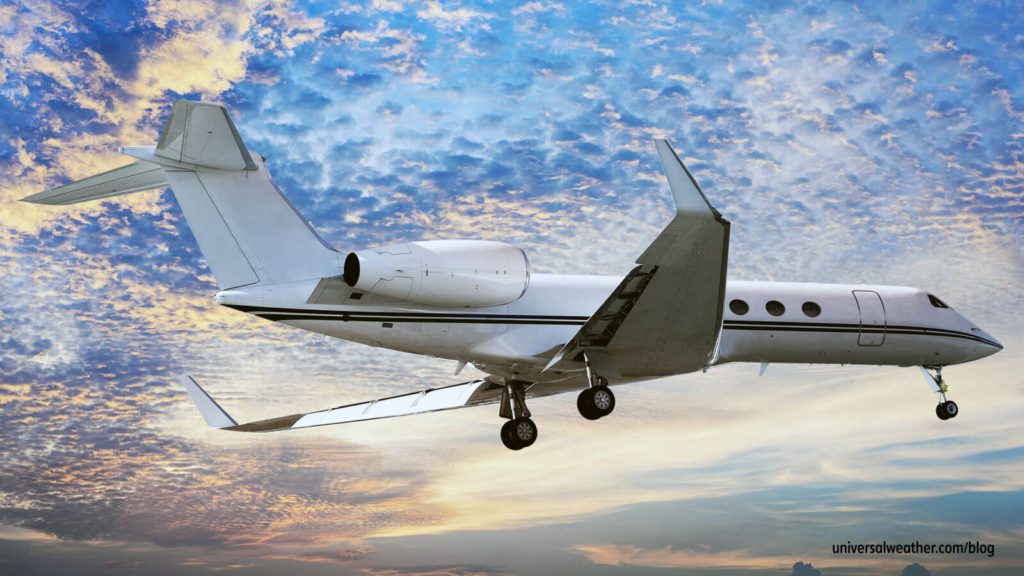Business Aviation Weather: International Standard Atmosphere – How It Affects Flight

The International Standard Atmosphere (ISA) is a foundational model in aviation, used to calibrate aircraft instruments and set performance benchmarks. While the ISA is theoretical, it provides a consistent reference for atmospheric conditions—including temperature, pressure, and density—across different altitudes.
Knowing how ISA works and how deviations from standard conditions impact performance is critical to safe and efficient flight planning, especially at high altitudes or in hot conditions.
Here’s what you need to know.
What Is the ISA Model?
ISA is a theoretical atmosphere developed by ICAO. It assumes:
- No moisture (completely dry air)
- No wind or turbulence
- Standard pressure, temperature, and density profiles from sea level up through the stratosphere
The model is based on the thermodynamic equation and includes tables of values for temperature, pressure, and density at various altitudes. It doesn’t reflect real-time weather but serves as a baseline for performance and instrument calibration
Units and Conversions
ISA data is typically expressed in:
- Temperature: Degrees Celsius (but Fahrenheit or Kelvin may be used in some contexts)
- Altitude: Meters or feet
- Pressure: Millibars (mb), inches of mercury (in. Hg), or pounds per square inch (psi)
Operators and flight crews should be familiar with these units and conversions to avoid confusion during flight planning or performance calculations.
Standard Values and Deviation
ISA uses standard sea level conditions as its baseline:
- Pressure: 29.92 in. Hg (1,013.25 mb) or 14.7 psi
- Temperature: 15°C (59°F)
As altitude increases, both temperature and pressure decrease in a predictable way—known as the lapse rate. For example:
- At FL100: -4.8°C (23.3°F)
- At FL200: -24.6°C (-12.3°F)
- At FL300: -44.4°C (-49.9°F)
Above FL360 (approximately 11,000 meters), ISA assumes a constant temperature of -56.5°C (-69.7°F) up to around FL655.
Pressure drops by about half with every 18,000 feet gained in altitude:
- Sea level: 29.92 in. Hg
- 18,000 ft: ~14.94 in. Hg
- 36,000 ft: ~6.71 in. Hg
Understanding Lapse Rates
Lapse rate refers to how temperature changes with altitude. The ISA uses a standard lapse rate of:
- 2°C per 1,000 ft (or 6.5°C per 1,000 m) up to 36,000 ft
Above 36,000 ft, ISA assumes the temperature remains constant. In reality, lapse rates can vary:
- Dry adiabatic lapse rate: ~5.5°F per 1,000 ft
- Moist adiabatic lapse rate: ~2–3°F per 1,000 ft (depending on humidity)
The ISA model falls between these two, making it a consistent reference but not a substitute for actual atmospheric observations.
Why ISA Deviation Matters
When outside air temperatures are warmer than ISA standard (ISA+ conditions), aircraft performance is degraded. Effects include:
- Reduced climb rate
- Difficulty maintaining altitude
- Higher true airspeeds (TAS), which may increase fuel burn
Every aircraft has specific performance charts that relate temperature deviation from ISA to climb, cruise, and takeoff performance. Excessive ISA+ conditions may require:
- Adjusted weight and balance
- Longer takeoff roll
- Reassessment of climb gradients or alternate airports
ISA and Performance Planning
ISA is often used during:
- Preflight performance calculations
- Flight planning software inputs
- Route planning to avoid regions of excessive heat at cruise altitudes
However, real-world conditions may vary due to atmospheric inversions, weather systems, or moisture content. That’s why ISA should always be paired with:
- Constant pressure charts
- Temperature aloft forecasts
- Real-time observations from PIREPs or meteorological sources
Use Available Tools and Resources
There are many ways to access ISA-related data:
- Online ISA calculators
- OEM flight manuals and performance tables
- Constant pressure charts from your weather provider
While the model itself is theoretical, your planning tools will typically apply it as a baseline for real-world adjustments.
Conclusion
The ISA model may be theoretical, but it plays a very real role in aircraft performance and flight planning. Understanding how temperature and pressure deviate from ISA—and how those deviations affect your aircraft—can help crews make smarter operational decisions, reduce risk, and avoid unexpected performance limitations en route or during climb.
Always verify forecasted conditions against ISA expectations, especially in regions with high temperatures or at altitudes near service ceilings. A little extra planning can go a long way in ensuring safe, smooth operations.




